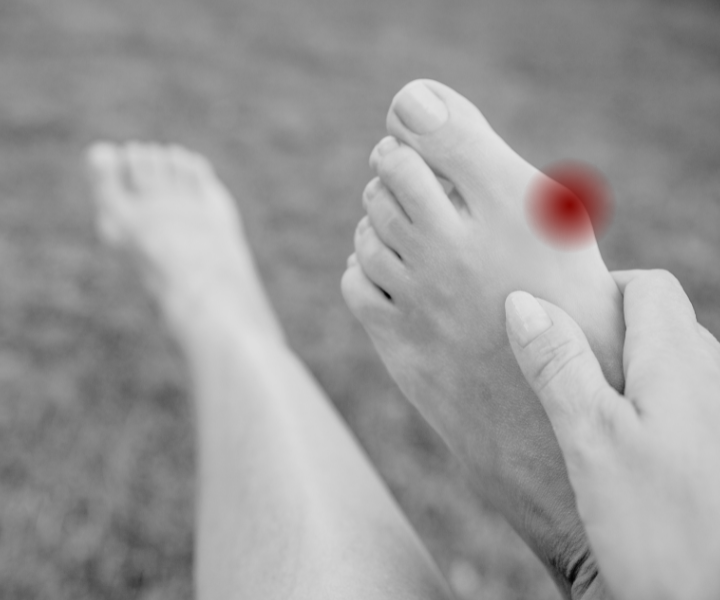What are Bunions
A bunion, medically known as hallux valgus, is a bony deformity that forms at the base of the big toe. It appears as a bony bump on the side of the foot, causing the big toe to deviate towards the other toes. Over time, the joint becomes misaligned, leading to pain, inflammation, and difficulty wearing certain footwear. Bunions can cause pain, discomfort, and affect mobility.
Causes of Bunions
Bunions can have various causes, including:
- Inherited Foot Structure: A foot structure inherited from family members can predispose an individual to developing bunions. Certain foot types, such as flat feet or excessive pronation, can increase the risk of bunion formation.
- Footwear Choices: Wearing tight, narrow shoes or high heels can place excessive pressure on the toes and lead to the development of bunions. Such footwear can push the toes together and force the big toe to bend towards the other toes.
- Joint Abnormalities: Some individuals have joint abnormalities or conditions, such as arthritis, that can contribute to the development of bunions.
The above may cause bunions, however it is not only these isolated reasons. Often bunions can be caused by one or more of the above in conjunction with each other.
Symptoms of Bunions
Bunions can cause a range of symptoms. The symptoms can often be physically seen, and may or may not involve associated pain. Signs of Bunions include:
- Bony Bump: The most noticeable symptom of a bunion is a bony bump at the base of the big toe. This bump can be red, swollen, and tender to the touch.
- Toe Misalignment: The big toe may gradually deviate towards the other toes, causing crowding and overlapping. This can lead to difficulties in finding properly fitting shoes.
- Pain and Discomfort: Bunions can cause pain and discomfort, especially during walking or wearing tight shoes. The affected area may also become inflamed and sensitive.
- Corns and Calluses: The misalignment of the toe can cause increased pressure and friction, leading to the formation of corns and calluses on the affected area.
How Can a Podiatrist Diagnose Bunions
A podiatrist can diagnose bunions through a comprehensive biomechanical assessment and examination. This includes:
- Medical History Review: Your podiatrist will discuss your symptoms, medical history, and any factors that may have contributed to the development of bunions.
- Physical Examination: Your podiatrist will visually inspect your foot, looking for signs of a bunion, such as a bony bump, redness, or swelling. They will also assess the alignment of the toes and examine your gait.
- Range of Motion Tests: Your podiatrist may assess the range of motion of your big toe joint to determine any restrictions or limitations caused by the bunion.
- X-rays: In some cases, your podiatrist may order X-rays to assess the severity of the bunion, evaluate joint alignment, and rule out other potential conditions.
How Can a Podiatrist Treat Bunions
Podiatrists offer various treatment options to manage bunions effectively. The choice of treatment depends on the severity of the bunion and the presence of symptoms. Common treatment approaches include:
Footwear Recommendations: Your podiatrist may advise wearing wider, more comfortable shoes with ample room for the toes. This can help reduce pressure on the bunion and alleviate symptoms.
Orthotic Devices: Custom-made orthotic inserts can be prescribed to provide support and cushioning, promoting proper foot alignment and reducing discomfort associated with bunions.
Padding and Taping: Your podiatrist may recommend padding or taping techniques to help reduce friction, pressure, and pain caused by the bunion. This can provide temporary relief and protection for the affected area.
Physical Therapy: Specific exercises and stretches can be prescribed by a podiatrist to improve foot strength, flexibility, and joint mobility. This can help alleviate symptoms and prevent further progression of the bunion.
Bunion Splints or Toe Spacers: Splints or toe spacers can be used to help realign the toes and relieve pressure on the bunion. These devices are typically used at night or during periods of rest. Please consult your podiatrist ahead of using these devices to ensure they are suitable for you.
Bunion Treatment and Prevention
In addition to treatment, certain preventive measures can help manage bunions and reduce the risk of their progression:
- Wear Proper Footwear: Opt for shoes that provide ample room for the toes, have a wide toe box, and low heels. Avoid tight, narrow, or pointed shoes that can exacerbate symptoms and contribute to bunion development.
- Toe Exercises: Perform regular toe exercises, such as toe stretches, toe curls, and picking up objects with your toes. These exercises can help strengthen the foot muscles and maintain flexibility. Your podiatrist can discuss the best exercises to perform based on your specific case.
- Maintain a Healthy Weight: Excess body weight can put additional pressure on the feet and exacerbate bunion symptoms. Maintaining a healthy weight can help reduce this pressure.
- Regular Foot Care: Observation can be key to noticing visual changes that might be an indicator of something more happening. Ensure you follow a good foot hygiene routine, keep the feet clean and dry, and inspect them regularly for any signs of irritation or changes. Address any foot discomfort or abnormalities promptly with your podiatrist to prevent complications.
- Surgical Intervention: In severe cases where conservative treatments have failed to provide relief, surgical intervention may be considered. A podiatrist can discuss the potential benefits and risks of surgery based on individual circumstances.
Summary
Bunions are a common condition and can cause significant pain, discomfort, along with visual abnormalities.
If you think you may have early signs of bunions, established bunions, or are experiencing related symptoms we encourage you to book an appointment with our friendly team of Podiatrists for BunionsTreatment in Melbourne, please call 03 9878 4566 or email [email protected] and we can book you in for a Biomechanical Assessment in the closest clinic location that suits you; Blackburn, Melbourne CBD, Newport, Elsternwick, Caroline Springs or Springvale.

